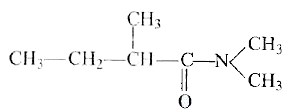C6H5−CH2−INaN3−−−−−→Δ Products
Reaction is assumed to involve nitrene as intermediate, then various possible products are :
C6H5CH2NH2
C6H5N=CH2
C6H5CH=NH

The correct Answer is:B, C
To solve the question regarding the reaction of C₆H₅-CH₂-I with NaN₃, we will follow these steps:
Step 1: Identify the Reactants
The reactants in this reaction are:
- C₆H₅-CH₂-I (Benzyl iodide)
- NaN₃ (Sodium azide)
Step 2: Understand the Role of Nitrene
The problem states that the reaction involves nitrene as an intermediate. Nitrenes are reactive species containing a nitrogen atom with a valence of three, typically represented as R-N: (where R is a carbon chain).
Step 3: Reaction Mechanism
1. Nucleophilic Substitution: The iodide (I) in benzyl iodide is a good leaving group. When NaN₃ is added, the azide ion (N₃⁻) will attack the carbon atom bonded to the iodine, resulting in the formation of an intermediate.
C₆H₅−CH₂−I+NaN₃→C₆H₅−CH₂−N₃+NaI
2. Formation of Nitrene: The azide group (N₃) can undergo a rearrangement to form a nitrene intermediate. This nitrene can then lose nitrogen gas (N₂) to yield a more stable product.
Step 4: Elimination of Nitrogen Gas
The nitrene intermediate can eliminate nitrogen gas (N₂), leading to the formation of a double bond between the carbon and nitrogen.
Step 5: Final Product Formation
The final product after the elimination of nitrogen gas will be:
C₆H₅−CH=NH
This product is known as a benzyl imine.
Conclusion
The major product formed from the reaction of C₆H₅-CH₂-I with NaN₃, assuming nitrene as an intermediate, is:
C₆H₅−CH=NH
The reactants in this reaction are:
- C₆H₅-CH₂-I (Benzyl iodide)
- NaN₃ (Sodium azide)
The problem states that the reaction involves nitrene as an intermediate. Nitrenes are reactive species containing a nitrogen atom with a valence of three, typically represented as R-N: (where R is a carbon chain).
1. Nucleophilic Substitution: The iodide (I) in benzyl iodide is a good leaving group. When NaN₃ is added, the azide ion (N₃⁻) will attack the carbon atom bonded to the iodine, resulting in the formation of an intermediate.
C₆H₅−CH₂−I+NaN₃→C₆H₅−CH₂−N₃+NaI
The nitrene intermediate can eliminate nitrogen gas (N₂), leading to the formation of a double bond between the carbon and nitrogen.
The final product after the elimination of nitrogen gas will be:
C₆H₅−CH=NH
This product is known as a benzyl imine.
The major product formed from the reaction of C₆H₅-CH₂-I with NaN₃, assuming nitrene as an intermediate, is:
C₆H₅−CH=NH
Similar Questions
Knowledge Check
- Question 1 - Select One
H3C−CH2−CH3∣CH−C∣∣O−NH2Br2+KOH−−−−−−−−−→ΔA1.CH3I(excess)−−−−−−−−−−−−→2.AgOH,ΔB
The major product (B) is :ACH3−CH2−CH=CH2B CH3C−CH=CH−CH3D
CH3C−CH=CH−CH3D
- Question 2 - Select One
CH3−CH∣OH−CH2−CH3conc.H2SO4−−−−−−→Product (I)+Product (II)
What is not true regarding the products ?AProduct-I and II are position isomersBProduct-I and II contains the same number od sp3andsp2 carbon atomsCThe yield of the product I and II is sameDReaction obeys Saytzeff rule - Question 3 - Select One
CH3−CH2−CH2−CH2−CH3∣C∣CH3−CH2−OHH+−−→ΔA(major) product (A) is :
ACH3−CH2−CH2−CH2−CH2−C∣CH3=CH−CH3B CCH3−CH2−CH2−CH2−C∣CH3=CH2DCH3−CH2−CH∣CH3−CH2−CH3∣C−CH2
CCH3−CH2−CH2−CH2−C∣CH3=CH2DCH3−CH2−CH∣CH3−CH2−CH3∣C−CH2
C6H5CHO+CH3COOCOCH3CH3COONa−−−−−−−→Δ products
If one product of above reaction is C6H5−CH=CH−COOH the other organic product (side product) isView Solution2CH3−C∣∣O−CH3Mg/Hg−−−−→H+ Product in the reaction is
View SolutionCH3CH2C∣CH3=CHCH3Reagent−−−−→CH3CH2CH∣CH3OH∣CHCH3
Which reagent forms the above organic product as the single product in the above reaction?View SolutionCH3−CH3∣CH∣CH3KmnO4−−−−→(A)H+−−→Δ(B)HBr−−−→ROOR(C)
Product (C) in the above reactions is :View SolutionConsider the following reactions
I.
II.(CH3)2C∣OH−CH2−CHOΔ−−→
III. (CH3)2CHCH2−C∣FH−CH3CH3O−Na+−−−−−−−−−−→Δ
IV. (CH3)2CH−C∣BrH−CH3(CH3)3CO−k+−−−−−−−−−−→
Which of these reaction will not produce Hoffmann product?View Solution
